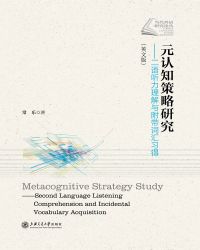3.8.1 The Correlational Study
您可以在百度里搜索“元认知策略研究:二语听力理解与附带词汇习得(英文版) 艾草文学(www.321553.xyz)”查找最新章节!
3.8.1 The Correlational Study
The correlational study aimed to investigate the relationship between learner's metacognitive listening awareness and their listening comprehension as well as their incidental vocabulary acquisition. This section first reports the relationship between learner's metacognitive listening awareness and their listening comprehension, and then the relationship between learners' metacognitive listening awareness and their incidental vocabulary acquisition.
3.8.1.1 Relationship between the Participants' Metacognitive Awareness (MA) and Their Listening Comprehension (LC)
Table 13 Pearson Correlations of the Participants'MA and LC in Task One
** Correlation is significant at the 0.01 level (2-tailed).
Table 14 Pearson Correlations of the Participants'MA and LC in Task Two
* Correlation is significant at the 0.05 level (2-tailed).
** Correlation is significant at the 0.01 level (2-tailed).
The above two tables list the statistically significant Pearson correlations of the participants' scores on the MALQ and the two listening comprehension tasks (see Table 1 and Table 2 in Appendix B for the full tables of Pearson Correlations of the Participants'MA and LC in Task One and Task Two). The correlations of Group A's scores on the two listening tasks and the metacognitive awareness of problem solving were statistically significant. The double asterisks indicates that the estimate of 0.417 and 0.508 were statistically significant at the 0.01 level, a 99% degree of confidence. The correlations of Group A's person knowledge awareness and directed attention awareness were also statistically significant respectively with listening task one and task two at the 0.01 level. The correlations of Group B's scores on listening comprehension task two andthe metacognitive awareness of directed attention were statistically significant. The one asterisk indicates that the estimate of 0.369 was statistically significant at the 0.05 level, a 95% degree of confidence.
One possible explanation of why problem solving awareness was significantly and consistently correlated with listening comprehension scores in only Group A is that the differences in metacognitive awareness were negated when instructional treatments were provided in terms of listening three times, either with or without a pre-listening activity. Therefore, significance only occurred when students were given authentic type listening (listening for one time only). Thus, a conclusion can be drawn here that metacognitive strategies were more important and apparent when learners were engaged in authentic type listening tasks.
3.8.1.2 Relationship between the Participants' Metacognitive Awareness (MA) and Incidental Vocabulary Acquisition (IVA)
(a) Relationship between MA and IVA for Group A
Table 15 Pearson Correlations of Group A Participants'MA and IVA in Task One
* Correlation is significant at the 0.05 level (2-tailed).
Table 16 Pearson Correlations of Group A Participants'MA and IVA in Task Two
* Correlation is significant at the 0.05 level (2-tailed).
** Correlation is significant at the 0.01 level (2-tailed).
The two tables above list the statistically significant Pearson correlations of the participants in Group A's scores on metacognitive listening awareness and incidental vocabulary acquisition in the two tasks (see Table 3 and Table 4 in the Appendix B for the full tables of Pearson Correlations of the Participants'MA and IVA for Group A in Task One and Task Two). In both tasks, scores for problem solving awareness were statistically significantly correlated with the reception test. When scores of awareness were compared with the vocabulary test in task two, the correlation between scores on person knowledge awareness and the form test was statistically significant at the 0.01 level. The general result showed that for the students who listened to the text just once, the more aware of problem solving strategy they were, the higher their scores on the reception test. One possible reason for this finding is that in terms of vocabulary acquisition, the listening texts only aided vocabulary gains in form and meaning, but not in production. This can be interpreted to mean that oral input words were much easier to acquire for reception than for production.
(b) Relationship between MA and IVA for Group B
Table 17 Pearson Correlations of Group B Participants'MA and IVA in Task One
* Correlation is significant at the 0.05 level (2-tailed).
Table 18 Pearson Correlations of Group B Participants'MA and IVA in Task Two
* Correlation is significant at the 0.05 level (2-tailed).
** Correlation is significant at the 0.01 level (2-tailed).
The above tables list the statistically significant Pearson correlations of the participants in Group B's scores on metacognitive awareness and incidental vocabulary acquisition in the two tasks (see Table 5 and Table 6 in the Appendix B for the full tables of Pearson Correlations of the Participants'MA and IVA for Group B in Task One and Task Two). For the students who listened to the text three times at different speeds, scores on five groups of metacognitive awareness were compared separately with scores of each vocabulary acquisition test. In Task One, only directed attention awareness was found to have a significant correlation with the production test, and in Task Two the correlations between scores on directed attention awareness and form tests were statistically significant, and also in Task Two, person knowledge awareness was found to have significant correlation with the form test. However, the two tables failed to present any consistent findings, and thus no conclusion can be drawn that there is any relationship between metacognitive listening awareness and incidental vocabulary acquisition for students who listened three times at different speeds.
(c) Relationship between MA and IVA for Group C
Table 19 Pearson Correlations of Group C Participants' MA and IVA in Task Two
* Correlation is significant at the 0.05 level (2-tailed).
Table 19 lists the statistically significant Pearson correlation of the participants in Group C's scores on metacognitive awareness and incidental vocabulary acquisition in Listening Task Two (see Table 7 and Table 8 in Appendix B for the full tables of Pearson Correlations of the Participants' MA and IVA for Group C in Task One and Task Two). For the students who had a topic-familiarization activity before listening to the text three times, scores on five groups of metacognitive awareness were compared separately with scores of each vocabulary acquisition test. However, almost no correlation was found, except that in Task Two directed attention awareness was found to have a significant correlation with the production test. It may then be concluded that metacognitive awareness was not significantly related to incidental vocabulary acquisition for students who listened three times with a pre-listening topic-familiarization activity.
3.8.1.3 Summary of the Correlational Study Results
The main finding of the relationship between learners' metacognitive listening awareness and their listening comprehension and incidental vocabulary acquisition can be summarized as follows.
(a) Problem solving awareness was only significantly correlated with vocabulary acquisition scores in Group A. In other words, the students who listened to the text just one time achieved higher scores on listening comprehension when they were more aware of problem solving strategies.
(b) Statistically, Group A's problem solving awareness scores were significantly correlated with reception test scores in both of the listening tasks. The results showed that for the students who listened to the text just once, the more aware they were of problem solving strategies, the better vocabulary acquisition they achieved as shown by their scores on the reception tests.
(c) For the students in Group B and Group C, no overall relationships were found between their metacognitive awareness and incidental vocabulary acquisition. 元认知策略研究:二语听力理解与附带词汇习得(英文版)




